Chapter 5 Multi-path mpeloration results
Here we present the results for the best performances and activation gene coverage generated by each selection scheme replicate on the multi-path mpeloration diagnostic. Best performance found refers to the largest average trait score found in a given population. Note that activation gene coverage values are gathered at the population-level. Activation gene coverage refers to the count of unique activation genes in a given population; this gives us a range of integers between 0 and 100.
5.2 Performance
Performance analysis.
5.2.1 Over time
Best performance in a population over time.
# data for lines and shading on plots
lines = filter(cc_over_time, diagnostic == 'multipath_exploration') %>%
group_by(`Selection\nScheme`, gen) %>%
dplyr::summarise(
min = min(pop_fit_max) / DIMENSIONALITY,
mean = mean(pop_fit_max) / DIMENSIONALITY,
max = max(pop_fit_max) / DIMENSIONALITY
)## `summarise()` has grouped output by 'Selection Scheme'. You can override using
## the `.groups` argument.ggplot(lines, aes(x=gen, y=mean, group = `Selection\nScheme`, fill =`Selection\nScheme`, color = `Selection\nScheme`, shape = `Selection\nScheme`)) +
geom_ribbon(aes(ymin = min, ymax = max), alpha = 0.1) +
geom_line(size = 0.5) +
geom_point(data = filter(lines, gen %% 2000 == 0 & gen != 0), size = 1.5, stroke = 2.0, alpha = 1.0) +
scale_y_continuous(
name="Average trait score",
limits=c(0, 100),
breaks=seq(0,100, 20),
labels=c("0", "20", "40", "60", "80", "100")
) +
scale_x_continuous(
name="Generations",
limits=c(0, 50000),
breaks=c(0, 10000, 20000, 30000, 40000, 50000),
labels=c("0e+4", "1e+4", "2e+4", "3e+4", "4e+4", "5e+4")
) +
scale_shape_manual(values=SHAPE)+
scale_colour_manual(values = cb_palette) +
scale_fill_manual(values = cb_palette) +
ggtitle('Performance over time')+
p_theme + theme(legend.title=element_blank(),legend.text=element_text(size=11)) +
guides(
shape=guide_legend(ncol=2, title.position = "bottom"),
color=guide_legend(ncol=2, title.position = "bottom"),
fill=guide_legend(ncol=2, title.position = "bottom")
)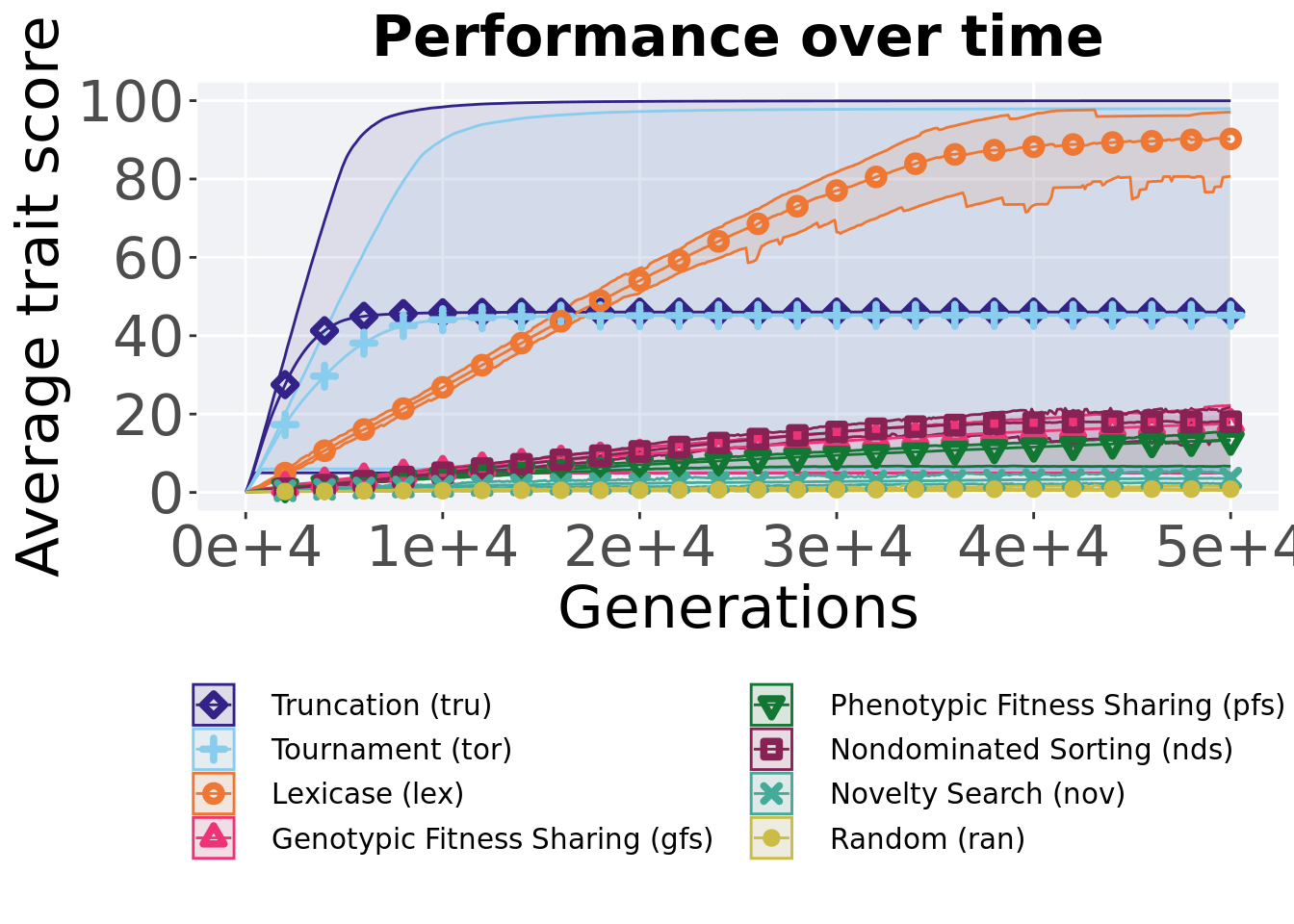
5.2.2 Best performance throughout
Best performance throughout 50,000 generations.
### best performance throughout
filter(cc_best, col == 'pop_fit_max' & diagnostic == 'multipath_exploration') %>%
ggplot(., aes(x = acron, y = val / DIMENSIONALITY, color = acron, fill = acron, shape = acron)) +
geom_flat_violin(position = position_nudge(x = .2, y = 0), scale = 'width', alpha = 0.2) +
geom_point(position = position_jitter(width = .1), size = 1.5, alpha = 1.0) +
geom_boxplot(color = 'black', width = .2, outlier.shape = NA, alpha = 0.0) +
guides(fill = "none",color = 'none', shape = 'none') +
scale_y_continuous(
name="Average trait score",
limits=c(-1, 101),
breaks=seq(0,100, 20),
labels=c("0", "20", "40", "60", "80", "100")
) +
scale_x_discrete(
name="Scheme"
)+
scale_shape_manual(values=SHAPE)+
scale_colour_manual(values = cb_palette, ) +
scale_fill_manual(values = cb_palette) +
ggtitle('Best performance throughout')+
p_theme + theme(legend.title=element_blank()) +
guides(
shape=guide_legend(nrow=2, title.position = "bottom"),
color=guide_legend(nrow=2, title.position = "bottom"),
fill=guide_legend(nrow=2, title.position = "bottom")
)
5.2.2.1 Stats
Summary statistics for the best performance.
### best performance throughout
performance = filter(cc_best, col == 'pop_fit_max' & diagnostic == 'multipath_exploration')
performance$acron = factor(performance$acron, levels = c('lex','tor','tru','nds','gfs','pfs','nov','ran'))
performance %>%
group_by(acron) %>%
dplyr::summarise(
count = n(),
na_cnt = sum(is.na(val)),
min = min(val / DIMENSIONALITY, na.rm = TRUE),
median = median(val / DIMENSIONALITY, na.rm = TRUE),
mean = mean(val / DIMENSIONALITY, na.rm = TRUE),
max = max(val / DIMENSIONALITY, na.rm = TRUE),
IQR = IQR(val / DIMENSIONALITY, na.rm = TRUE)
)## # A tibble: 8 x 8
## acron count na_cnt min median mean max IQR
## <fct> <int> <int> <dbl> <dbl> <dbl> <dbl> <dbl>
## 1 lex 50 0 83.4 93.2 92.5 97.7 4.05
## 2 tor 50 0 6.00 42.5 45.2 97.9 53.2
## 3 tru 50 0 5 44.0 46.1 100. 49.7
## 4 nds 50 0 16.2 19.9 19.8 22.5 1.59
## 5 gfs 50 0 4.99 20.4 17.6 22.2 6.69
## 6 pfs 50 0 6.76 13.5 13.4 15.6 1.10
## 7 nov 50 0 2.62 3.89 4.01 5.68 0.860
## 8 ran 50 0 0.870 1.25 1.28 2.04 0.288Kruskal–Wallis test provides evidence of difference among best performances.
##
## Kruskal-Wallis rank sum test
##
## data: val by acron
## Kruskal-Wallis chi-squared = 329.88, df = 7, p-value < 2.2e-16Results for post-hoc Wilcoxon rank-sum test with a Bonferroni correction on best performance.
pairwise.wilcox.test(x = performance$val, g = performance$acron, p.adjust.method = "bonferroni",
paired = FALSE, conf.int = FALSE, alternative = 'l')##
## Pairwise comparisons using Wilcoxon rank sum test with continuity correction
##
## data: performance$val and performance$acron
##
## lex tor tru nds gfs pfs nov
## tor 3.0e-13 - - - - - -
## tru 1.1e-11 1.00000 - - - - -
## nds < 2e-16 0.00047 0.00027 - - - -
## gfs < 2e-16 2.3e-05 1.6e-05 1.00000 - - -
## pfs < 2e-16 3.1e-08 6.9e-10 < 2e-16 0.00015 - -
## nov < 2e-16 < 2e-16 < 2e-16 < 2e-16 < 2e-16 < 2e-16 -
## ran < 2e-16 < 2e-16 < 2e-16 < 2e-16 < 2e-16 < 2e-16 < 2e-16
##
## P value adjustment method: bonferroni5.2.3 End of 50,000 generations
Best performance in the population at the end of 50,000 generations.
# end of run
filter(cc_over_time, diagnostic == 'multipath_exploration' & gen == 50000) %>%
ggplot(., aes(x = acron, y = pop_fit_max / DIMENSIONALITY, color = acron, fill = acron, shape = acron)) +
geom_flat_violin(position = position_nudge(x = .2, y = 0), scale = 'width', alpha = 0.2) +
geom_point(position = position_jitter(width = .1), size = 1.5, alpha = 1.0) +
geom_boxplot(color = 'black', width = .2, outlier.shape = NA, alpha = 0.0) +
guides(fill = "none",color = 'none', shape = 'none') +
scale_y_continuous(
name="Coverage",
limits=c(0, 100),
breaks=seq(0,100, 20),
labels=c("0", "20", "40", "60", "80", "100")
) +
scale_x_discrete(
name="Scheme"
)+
scale_shape_manual(values=SHAPE)+
scale_colour_manual(values = cb_palette, ) +
scale_fill_manual(values = cb_palette) +
ggtitle('Final performance')+
p_theme + theme(legend.title=element_blank()) +
guides(
shape=guide_legend(nrow=2, title.position = "bottom"),
color=guide_legend(nrow=2, title.position = "bottom"),
fill=guide_legend(nrow=2, title.position = "bottom")
)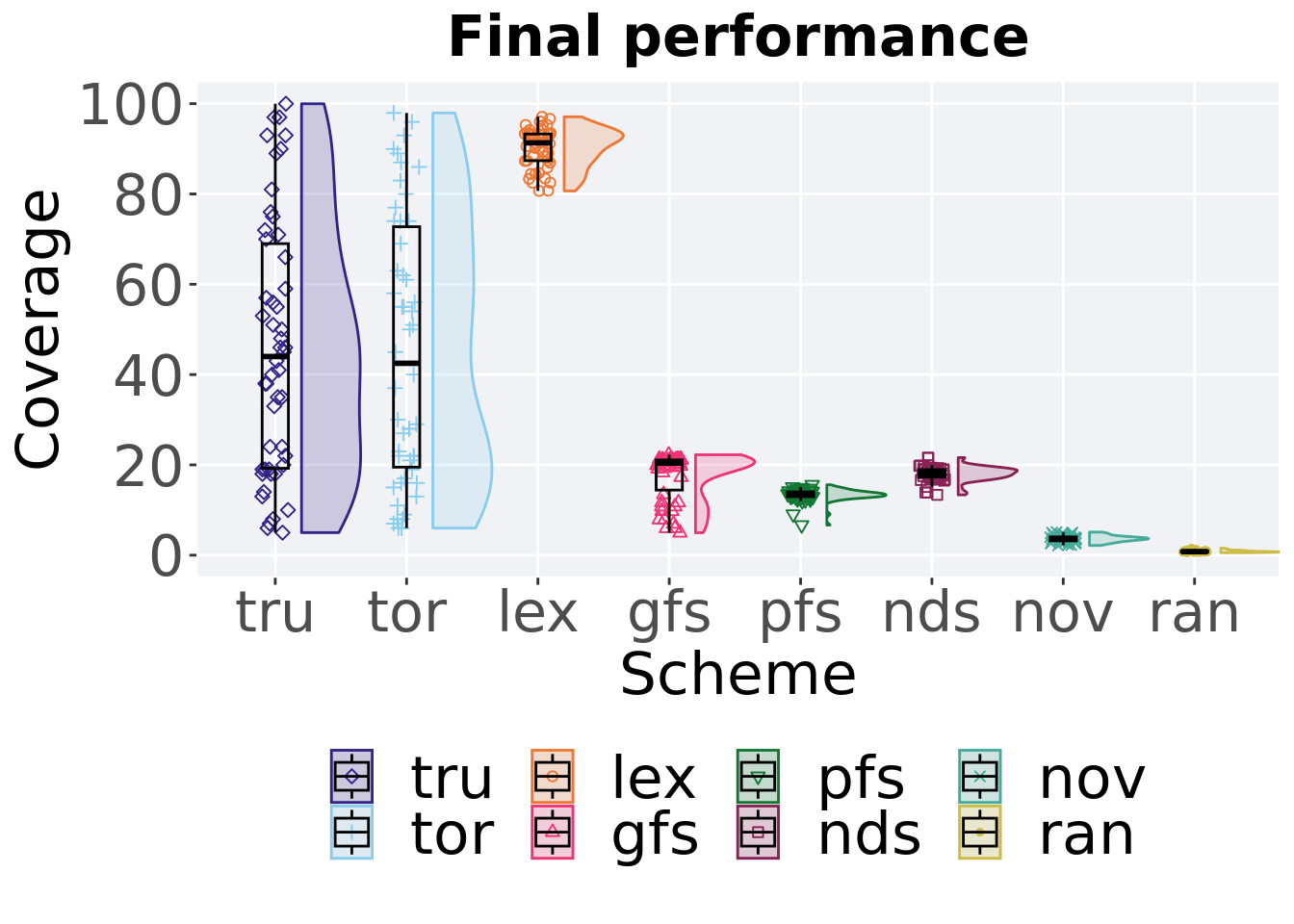
5.2.3.1 Stats
Summary statistics for best performance in the final population.
# end of run
performance = filter(cc_over_time, diagnostic == 'multipath_exploration' & gen == 50000)
performance$acron = factor(performance$acron, levels = c('lex','tor','tru','nds','gfs','pfs','nov','ran'))
performance %>%
group_by(acron) %>%
dplyr::summarise(
count = n(),
na_cnt = sum(is.na(pop_fit_max / DIMENSIONALITY)),
min = min(pop_fit_max / DIMENSIONALITY, na.rm = TRUE),
median = median(pop_fit_max / DIMENSIONALITY, na.rm = TRUE),
mean = mean(pop_fit_max / DIMENSIONALITY, na.rm = TRUE),
max = max(pop_fit_max / DIMENSIONALITY, na.rm = TRUE),
IQR = IQR(pop_fit_max / DIMENSIONALITY, na.rm = TRUE)
)## # A tibble: 8 x 8
## acron count na_cnt min median mean max IQR
## <fct> <int> <int> <dbl> <dbl> <dbl> <dbl> <dbl>
## 1 lex 50 0 80.7 91.3 90.2 97.1 5.91
## 2 tor 50 0 6.00 42.5 45.2 97.9 53.2
## 3 tru 50 0 5 44.0 46.1 100. 49.7
## 4 nds 50 0 13.4 18.1 18.0 21.6 1.65
## 5 gfs 50 0 4.96 20.4 17.6 22.2 6.68
## 6 pfs 50 0 6.67 13.5 13.3 15.6 1.04
## 7 nov 50 0 2.16 3.66 3.64 5.12 0.859
## 8 ran 50 0 0.553 0.785 0.840 1.56 0.299Kruskal–Wallis test provides evidence of difference among best performance in the final population.
##
## Kruskal-Wallis rank sum test
##
## data: pop_fit_max by acron
## Kruskal-Wallis chi-squared = 330.05, df = 7, p-value < 2.2e-16Results for post-hoc Wilcoxon rank-sum test with a Bonferroni correction on best performance in the final population.
pairwise.wilcox.test(x = performance$pop_fit_max, g = performance$acron, p.adjust.method = "bonferroni",
paired = FALSE, conf.int = FALSE, alternative = 'l')##
## Pairwise comparisons using Wilcoxon rank sum test with continuity correction
##
## data: performance$pop_fit_max and performance$acron
##
## lex tor tru nds gfs pfs nov
## tor 3.9e-12 - - - - - -
## tru 7.1e-11 1.00000 - - - - -
## nds < 2e-16 8.2e-05 9.3e-07 - - - -
## gfs < 2e-16 2.2e-05 1.6e-05 1.00000 - - -
## pfs < 2e-16 3.0e-08 6.6e-10 3.0e-15 0.00015 - -
## nov < 2e-16 < 2e-16 < 2e-16 < 2e-16 < 2e-16 < 2e-16 -
## ran < 2e-16 < 2e-16 < 2e-16 < 2e-16 < 2e-16 < 2e-16 < 2e-16
##
## P value adjustment method: bonferroni5.3 Activation gene coverage
Activation gene coverage analysis.
5.3.1 Over time coverage
Activation gene coverage over time.
# data for lines and shading on plots
lines = filter(cc_over_time, diagnostic == 'multipath_exploration') %>%
group_by(`Selection\nScheme`, gen) %>%
dplyr::summarise(
min = min(uni_str_pos),
mean = mean(uni_str_pos),
max = max(uni_str_pos)
)## `summarise()` has grouped output by 'Selection Scheme'. You can override using
## the `.groups` argument.ggplot(lines, aes(x=gen, y=mean, group = `Selection\nScheme`, fill =`Selection\nScheme`, color = `Selection\nScheme`, shape = `Selection\nScheme`)) +
geom_ribbon(aes(ymin = min, ymax = max), alpha = 0.1) +
geom_line(size = 0.5) +
geom_point(data = filter(lines, gen %% 2000 == 0 & gen != 0), size = 1.5, stroke = 2.0, alpha = 1.0) +
scale_y_continuous(
name="Coverage",
limits=c(0, 100),
breaks=seq(0,100, 20),
labels=c("0", "20", "40", "60", "80", "100")
) +
scale_x_continuous(
name="Generations",
limits=c(0, 50000),
breaks=c(0, 10000, 20000, 30000, 40000, 50000),
labels=c("0e+4", "1e+4", "2e+4", "3e+4", "4e+4", "5e+4")
) +
scale_shape_manual(values=SHAPE)+
scale_colour_manual(values = cb_palette) +
scale_fill_manual(values = cb_palette) +
ggtitle('Activation gene coverage over time')+
p_theme + theme(legend.title=element_blank(),legend.text=element_text(size=11)) +
guides(
shape=guide_legend(ncol=2, title.position = "bottom"),
color=guide_legend(ncol=2, title.position = "bottom"),
fill=guide_legend(ncol=2, title.position = "bottom")
)
5.3.2 End of 50,000 generations
Activation gene coverage in the population at the end of 50,000 generations.
# end of run
filter(cc_over_time, diagnostic == 'multipath_exploration' & gen == 50000) %>%
ggplot(., aes(x = acron, y = uni_str_pos, color = acron, fill = acron, shape = acron)) +
geom_flat_violin(position = position_nudge(x = .2, y = 0), scale = 'width', alpha = 0.2) +
geom_point(position = position_jitter(width = .1), size = 1.5, alpha = 1.0) +
geom_boxplot(color = 'black', width = .2, outlier.shape = NA, alpha = 0.0) +
guides(fill = "none",color = 'none', shape = 'none') +
scale_y_continuous(
name="Coverage",
limits=c(0, 100),
breaks=seq(0,100, 20),
labels=c("0", "20", "40", "60", "80", "100")
) +
scale_x_discrete(
name="Scheme"
)+
scale_shape_manual(values=SHAPE)+
scale_colour_manual(values = cb_palette, ) +
scale_fill_manual(values = cb_palette) +
ggtitle('Final activation gene coverage')+
p_theme + theme(legend.title=element_blank()) +
guides(
shape=guide_legend(nrow=2, title.position = "bottom"),
color=guide_legend(nrow=2, title.position = "bottom"),
fill=guide_legend(nrow=2, title.position = "bottom")
)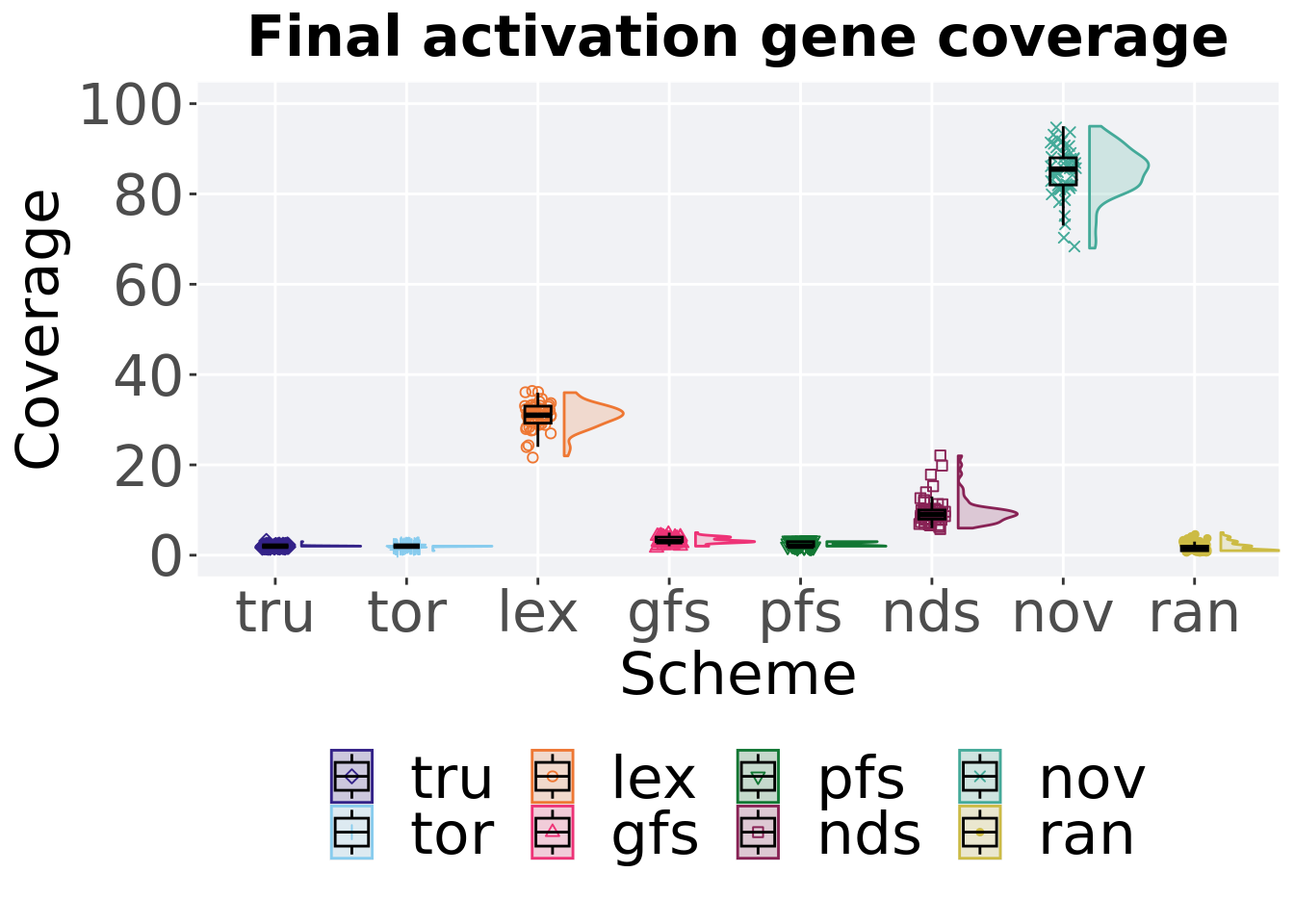
5.3.2.1 Stats
Summary statistics for activation gene coverage in the final population.
# end of run
coverage = filter(cc_over_time, diagnostic == 'multipath_exploration' & gen == 50000)
coverage$acron = factor(coverage$acron, levels = c('nov','lex','nds','gfs','pfs','tor','tru','ran'))
coverage %>%
group_by(acron) %>%
dplyr::summarise(
count = n(),
na_cnt = sum(is.na(uni_str_pos)),
min = min(uni_str_pos, na.rm = TRUE),
median = median(uni_str_pos, na.rm = TRUE),
mean = mean(uni_str_pos, na.rm = TRUE),
max = max(uni_str_pos, na.rm = TRUE),
IQR = IQR(uni_str_pos, na.rm = TRUE)
)## # A tibble: 8 x 8
## acron count na_cnt min median mean max IQR
## <fct> <int> <int> <int> <dbl> <dbl> <int> <dbl>
## 1 nov 50 0 68 85.5 84.9 95 6
## 2 lex 50 0 22 31 30.8 36 3.75
## 3 nds 50 0 6 9 9.76 22 2
## 4 gfs 50 0 2 3 3.24 5 1
## 5 pfs 50 0 2 2 2.46 3 1
## 6 tor 50 0 1 2 1.98 2 0
## 7 tru 50 0 2 2 2.02 3 0
## 8 ran 50 0 1 1.5 1.86 5 1Kruskal–Wallis test provides evidence of difference among activation gene coverage in the final population.
##
## Kruskal-Wallis rank sum test
##
## data: uni_str_pos by acron
## Kruskal-Wallis chi-squared = 351.29, df = 7, p-value < 2.2e-16Results for post-hoc Wilcoxon rank-sum test with a Bonferroni correction on activation gene coverage in the final population.
pairwise.wilcox.test(x = coverage$uni_str_pos, g = coverage$acron, p.adjust.method = "bonferroni",
paired = FALSE, conf.int = FALSE, alternative = 'l')##
## Pairwise comparisons using Wilcoxon rank sum test with continuity correction
##
## data: coverage$uni_str_pos and coverage$acron
##
## nov lex nds gfs pfs tor tru
## lex < 2e-16 - - - - - -
## nds < 2e-16 < 2e-16 - - - - -
## gfs < 2e-16 < 2e-16 < 2e-16 - - - -
## pfs < 2e-16 < 2e-16 < 2e-16 7.8e-07 - - -
## tor < 2e-16 < 2e-16 < 2e-16 4.2e-16 6.3e-07 - -
## tru < 2e-16 < 2e-16 < 2e-16 1.4e-15 4.3e-06 1.00000 -
## ran < 2e-16 < 2e-16 < 2e-16 1.1e-08 0.00073 0.20446 0.10598
##
## P value adjustment method: bonferroni5.4 Multi-valley crossing results
5.4.1 Performance
Performance analysis.
5.4.1.1 Performance over time
Best performance in a population over time.
# data for lines and shading on plots
lines = filter(cc_over_time_mvc, diagnostic == 'multipath_exploration') %>%
group_by(`Selection\nScheme`, gen) %>%
dplyr::summarise(
min = min(pop_fit_max) / DIMENSIONALITY,
mean = mean(pop_fit_max) / DIMENSIONALITY,
max = max(pop_fit_max) / DIMENSIONALITY
)## `summarise()` has grouped output by 'Selection Scheme'. You can override using
## the `.groups` argument.ggplot(lines, aes(x=gen, y=mean, group = `Selection\nScheme`, fill =`Selection\nScheme`, color = `Selection\nScheme`, shape = `Selection\nScheme`)) +
geom_ribbon(aes(ymin = min, ymax = max), alpha = 0.1) +
geom_line(size = 0.5) +
geom_point(data = filter(lines, gen %% 2000 == 0 & gen != 0), size = 1.5, stroke = 2.0, alpha = 1.0) +
scale_y_continuous(
name="Average trait score",
limits=c(0, 15),
breaks=seq(0,15, 5),
labels=c("0", "5", "10", "15")
) +
scale_x_continuous(
name="Generations",
limits=c(0, 50000),
breaks=c(0, 10000, 20000, 30000, 40000, 50000),
labels=c("0e+4", "1e+4", "2e+4", "3e+4", "4e+4", "5e+4")
) +
scale_shape_manual(values=SHAPE)+
scale_colour_manual(values = cb_palette) +
scale_fill_manual(values = cb_palette) +
ggtitle('Performance over time')+
p_theme + theme(legend.title=element_blank(),legend.text=element_text(size=11)) +
guides(
shape=guide_legend(ncol=2, title.position = "bottom"),
color=guide_legend(ncol=2, title.position = "bottom"),
fill=guide_legend(ncol=2, title.position = "bottom")
)
5.4.1.2 Best performance throughout
Best performance found throughout 50,000 generations.
### best performance throughout
filter(cc_best_mvc, col == 'pop_fit_max' & diagnostic == 'multipath_exploration') %>%
ggplot(., aes(x = acron, y = val / DIMENSIONALITY, color = acron, fill = acron, shape = acron)) +
geom_flat_violin(position = position_nudge(x = .2, y = 0), scale = 'width', alpha = 0.2) +
geom_point(position = position_jitter(width = .1), size = 1.5, alpha = 1.0) +
geom_boxplot(color = 'black', width = .2, outlier.shape = NA, alpha = 0.0) +
guides(fill = "none",color = 'none', shape = 'none') +
scale_y_continuous(
name="Average trait score",
limits=c(0, 15),
breaks=seq(0,15, 5),
labels=c("0", "5", "10", "15")
) +
scale_x_discrete(
name="Scheme"
)+
scale_shape_manual(values=SHAPE)+
scale_colour_manual(values = cb_palette, ) +
scale_fill_manual(values = cb_palette) +
ggtitle('Best performance throughout')+
p_theme + theme(legend.title=element_blank()) +
guides(
shape=guide_legend(nrow=2, title.position = "bottom"),
color=guide_legend(nrow=2, title.position = "bottom"),
fill=guide_legend(nrow=2, title.position = "bottom")
)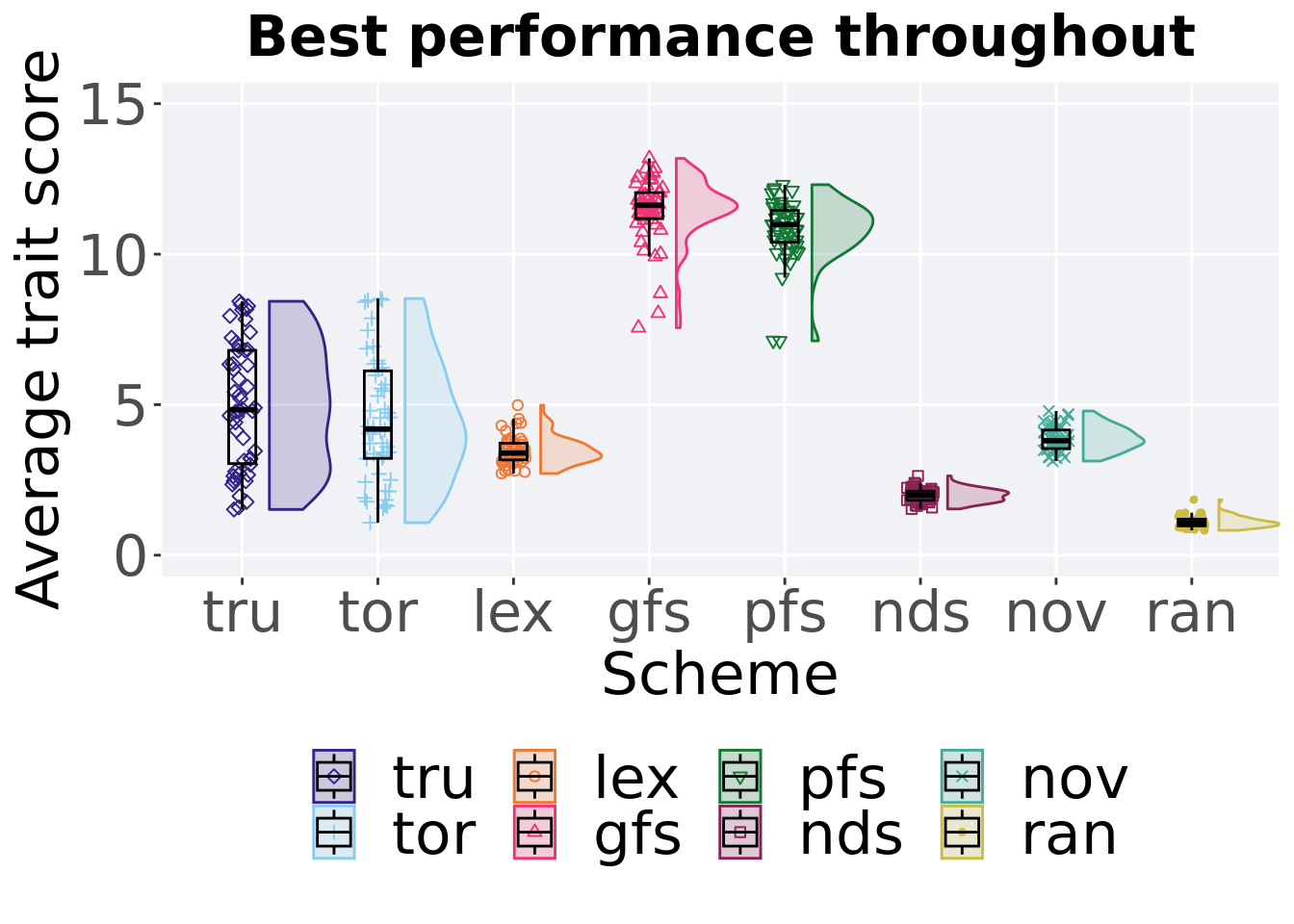
5.4.1.2.1 Stats
Summary statistics for the performance of the best performance.
### best performance throughout
performance = filter(cc_best_mvc, col == 'pop_fit_max' & diagnostic == 'multipath_exploration')
performance$acron = factor(performance$acron, levels = c('gfs','pfs','tor','tru','nov','lex','nds','ran'))
performance %>%
group_by(acron) %>%
dplyr::summarise(
count = n(),
na_cnt = sum(is.na(val)),
min = min(val / DIMENSIONALITY, na.rm = TRUE),
median = median(val / DIMENSIONALITY, na.rm = TRUE),
mean = mean(val / DIMENSIONALITY, na.rm = TRUE),
max = max(val / DIMENSIONALITY, na.rm = TRUE),
IQR = IQR(val / DIMENSIONALITY, na.rm = TRUE)
)## # A tibble: 8 x 8
## acron count na_cnt min median mean max IQR
## <fct> <int> <int> <dbl> <dbl> <dbl> <dbl> <dbl>
## 1 gfs 50 0 7.56 11.6 11.5 13.2 0.865
## 2 pfs 50 0 7.12 11.0 10.8 12.3 1.06
## 3 tor 50 0 1.08 4.19 4.50 8.53 2.91
## 4 tru 50 0 1.52 4.83 4.96 8.43 3.76
## 5 nov 50 0 3.13 3.80 3.88 4.79 0.617
## 6 lex 50 0 2.71 3.39 3.48 4.98 0.555
## 7 nds 50 0 1.54 1.99 1.98 2.63 0.307
## 8 ran 50 0 0.825 1.07 1.10 1.85 0.222Kruskal–Wallis test provides evidence of statistical differences.
##
## Kruskal-Wallis rank sum test
##
## data: val by acron
## Kruskal-Wallis chi-squared = 335.6, df = 7, p-value < 2.2e-16Results for post-hoc Wilcoxon rank-sum test with a Bonferroni correction.
pairwise.wilcox.test(x = performance$val, g = performance$acron, p.adjust.method = "bonferroni",
paired = FALSE, conf.int = FALSE, alternative = 'l')##
## Pairwise comparisons using Wilcoxon rank sum test with continuity correction
##
## data: performance$val and performance$acron
##
## gfs pfs tor tru nov lex nds
## pfs 0.00212 - - - - - -
## tor < 2e-16 < 2e-16 - - - - -
## tru < 2e-16 2.9e-16 1.00000 - - - -
## nov < 2e-16 < 2e-16 1.00000 0.18480 - - -
## lex < 2e-16 < 2e-16 0.08240 0.02364 0.00014 - -
## nds < 2e-16 < 2e-16 2.5e-09 1.7e-12 < 2e-16 < 2e-16 -
## ran < 2e-16 < 2e-16 5.2e-16 < 2e-16 < 2e-16 < 2e-16 2.6e-16
##
## P value adjustment method: bonferroni5.4.1.3 Performance comparison
Best performances in the population at 40,000 and 50,000 generations.
## Warning: The following aesthetics were dropped during statistical transformation:
## colour, shape
## i This can happen when ggplot fails to infer the correct grouping structure in
## the data.
## i Did you forget to specify a `group` aesthetic or to convert a numerical
## variable into a factor?
## The following aesthetics were dropped during statistical transformation:
## colour, shape
## i This can happen when ggplot fails to infer the correct grouping structure in
## the data.
## i Did you forget to specify a `group` aesthetic or to convert a numerical
## variable into a factor?# 80% and final generation comparison
end = filter(cc_over_time_mvc, diagnostic == 'multipath_exploration' & gen == 50000 & acron != 'ran')
end$Generation <- factor(end$gen)
mid = filter(cc_over_time_mvc, diagnostic == 'multipath_exploration' & gen == 40000 & acron != 'ran')
mid$Generation <- factor(mid$gen)
mvc_p = ggplot(mid, aes(x = acron, y=pop_fit_max / DIMENSIONALITY, group = acron, shape = Generation)) +
geom_point(col = mvc_col[1] , position = position_jitternudge(jitter.width = .03, nudge.x = -0.05), size = 2, alpha = 1.0) +
geom_boxplot(position = position_nudge(x = -.15, y = 0), lwd = 0.7, col = mvc_col[1], fill = mvc_col[1], width = .1, outlier.shape = NA, alpha = 0.0) +
geom_point(data = end, aes(x = acron, y=pop_fit_max / DIMENSIONALITY), col = mvc_col[2], position = position_jitternudge(jitter.width = .03, nudge.x = 0.05), size = 2, alpha = 1.0) +
geom_boxplot(data = end, aes(x = acron, y=pop_fit_max / DIMENSIONALITY), position = position_nudge(x = .15, y = 0), lwd = 0.7, col = mvc_col[2], fill = mvc_col[2], width = .1, outlier.shape = NA, alpha = 0.0) +
scale_y_continuous(
name="Average trait score",
limits=c(0, 15),
breaks=seq(0,15, 5),
labels=c("0", "5", "10", "15")
) +
scale_x_discrete(
name="Scheme"
)+
scale_shape_manual(values=c(0,1))+
scale_colour_manual(values = c(mvc_col[1],mvc_col[2])) +
p_theme
plot_grid(
mvc_p +
ggtitle("Performance comparisons") +
theme(legend.position="none"),
legend,
nrow=2,
rel_heights = c(1,.05),
label_size = TSIZE
)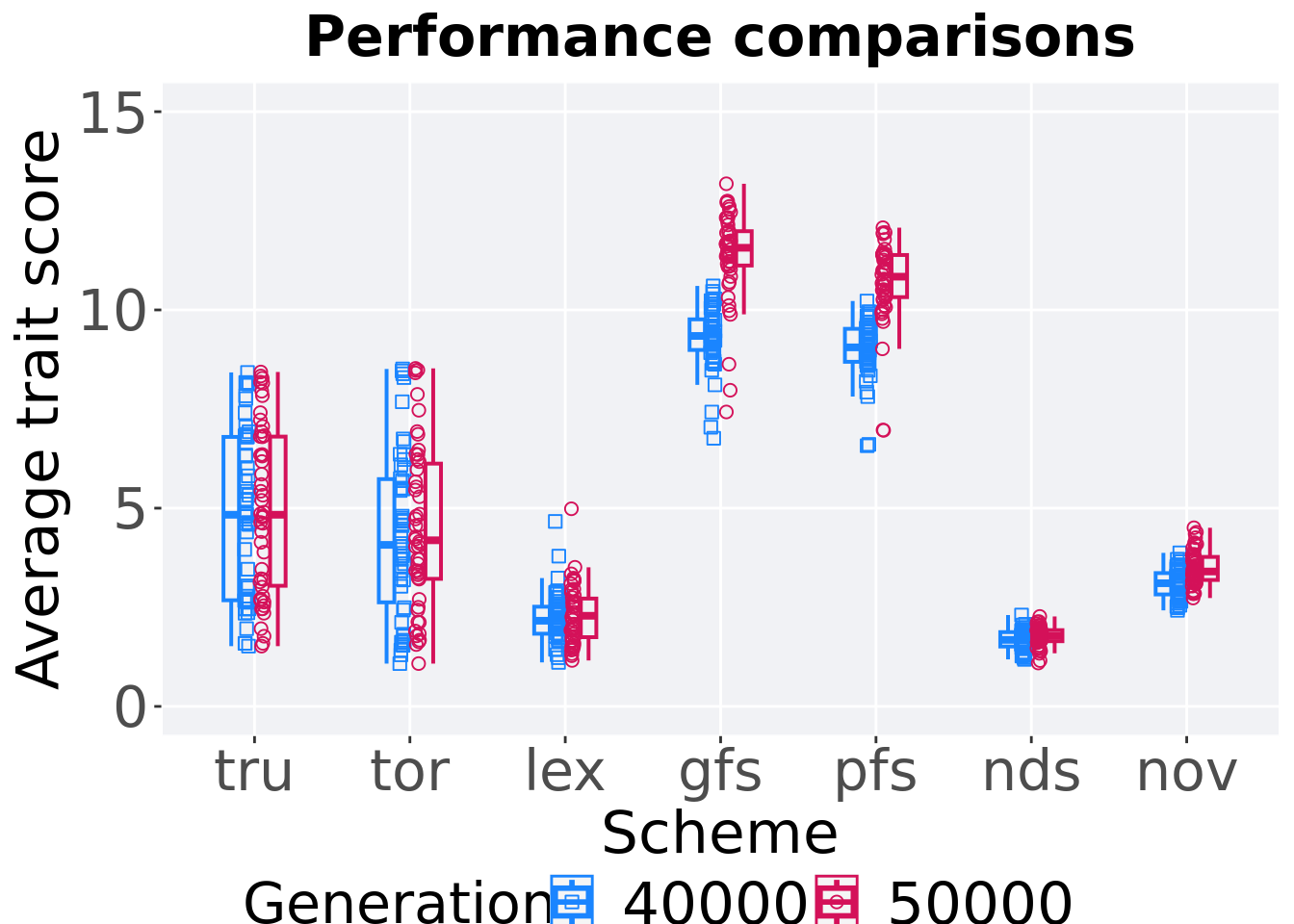
5.4.1.3.1 Stats
Summary statistics for the performance of the best performance at 40,000 and 50,000 generations.
### performance comparisons and generation slices 40K & 50K
slices = filter(cc_over_time_mvc, diagnostic == 'multipath_exploration' & (gen == 50000 | gen == 40000) & acron != 'ran')
slices$Generation <- factor(slices$gen, levels = c(50000,40000))
slices$acron = factor(slices$acron, levels = c('gfs','pfs','tru','tor','nov', 'nds','lex', 'ran'))
slices %>%
group_by(acron, Generation) %>%
dplyr::summarise(
count = n(),
na_cnt = sum(is.na(pop_fit_max / DIMENSIONALITY)),
min = min(pop_fit_max / DIMENSIONALITY, na.rm = TRUE),
median = median(pop_fit_max / DIMENSIONALITY, na.rm = TRUE),
mean = mean(pop_fit_max / DIMENSIONALITY, na.rm = TRUE),
max = max(pop_fit_max / DIMENSIONALITY, na.rm = TRUE),
IQR = IQR(pop_fit_max / DIMENSIONALITY, na.rm = TRUE)
)## `summarise()` has grouped output by 'acron'. You can override using the
## `.groups` argument.## # A tibble: 14 x 9
## # Groups: acron [7]
## acron Generation count na_cnt min median mean max IQR
## <fct> <fct> <int> <int> <dbl> <dbl> <dbl> <dbl> <dbl>
## 1 gfs 50000 50 0 7.43 11.6 11.4 13.2 0.865
## 2 gfs 40000 50 0 6.76 9.34 9.32 10.6 0.772
## 3 pfs 50000 50 0 6.96 10.8 10.7 12.1 1.06
## 4 pfs 40000 50 0 6.57 9.06 9.01 10.2 0.832
## 5 tru 50000 50 0 1.52 4.83 4.96 8.43 3.76
## 6 tru 40000 50 0 1.52 4.83 4.85 8.42 4.12
## 7 tor 50000 50 0 1.08 4.19 4.50 8.53 2.91
## 8 tor 40000 50 0 1.08 4.07 4.31 8.51 3.11
## 9 nov 50000 50 0 2.73 3.40 3.49 4.51 0.582
## 10 nov 40000 50 0 2.42 3.11 3.10 3.87 0.538
## 11 nds 50000 50 0 1.09 1.78 1.76 2.27 0.279
## 12 nds 40000 50 0 1.19 1.68 1.68 2.30 0.363
## 13 lex 50000 50 0 1.16 2.29 2.30 4.98 0.974
## 14 lex 40000 50 0 1.11 2.16 2.25 4.67 0.681Truncation selection comparisons.
wilcox.test(x = filter(slices, acron == 'tru' & Generation == 50000)$pop_fit_max,
y = filter(slices, acron == 'tru' & Generation == 40000)$pop_fit_max,
alternative = 't')##
## Wilcoxon rank sum test with continuity correction
##
## data: filter(slices, acron == "tru" & Generation == 50000)$pop_fit_max and filter(slices, acron == "tru" & Generation == 40000)$pop_fit_max
## W = 1317, p-value = 0.6466
## alternative hypothesis: true location shift is not equal to 0Tournament selection comparisons.
wilcox.test(x = filter(slices, acron == 'tor' & Generation == 50000)$pop_fit_max,
y = filter(slices, acron == 'tor' & Generation == 40000)$pop_fit_max,
alternative = 't')##
## Wilcoxon rank sum test with continuity correction
##
## data: filter(slices, acron == "tor" & Generation == 50000)$pop_fit_max and filter(slices, acron == "tor" & Generation == 40000)$pop_fit_max
## W = 1339, p-value = 0.5418
## alternative hypothesis: true location shift is not equal to 0Lexicase selection comparisons.
wilcox.test(x = filter(slices, acron == 'lex' & Generation == 50000)$pop_fit_max,
y = filter(slices, acron == 'lex' & Generation == 40000)$pop_fit_max,
alternative = 't')##
## Wilcoxon rank sum test with continuity correction
##
## data: filter(slices, acron == "lex" & Generation == 50000)$pop_fit_max and filter(slices, acron == "lex" & Generation == 40000)$pop_fit_max
## W = 1286, p-value = 0.8067
## alternative hypothesis: true location shift is not equal to 0Genotypic fitness sharing comparisons.
wilcox.test(x = filter(slices, acron == 'gfs' & Generation == 50000)$pop_fit_max,
y = filter(slices, acron == 'gfs' & Generation == 40000)$pop_fit_max,
alternative = 't')##
## Wilcoxon rank sum test with continuity correction
##
## data: filter(slices, acron == "gfs" & Generation == 50000)$pop_fit_max and filter(slices, acron == "gfs" & Generation == 40000)$pop_fit_max
## W = 2327, p-value = 1.161e-13
## alternative hypothesis: true location shift is not equal to 0Phenotypic fitness sharing comparisons.
wilcox.test(x = filter(slices, acron == 'pfs' & Generation == 50000)$pop_fit_max,
y = filter(slices, acron == 'pfs' & Generation == 40000)$pop_fit_max,
alternative = 't')##
## Wilcoxon rank sum test with continuity correction
##
## data: filter(slices, acron == "pfs" & Generation == 50000)$pop_fit_max and filter(slices, acron == "pfs" & Generation == 40000)$pop_fit_max
## W = 2358, p-value = 2.26e-14
## alternative hypothesis: true location shift is not equal to 0Nondominated sorting comparisons.
wilcox.test(x = filter(slices, acron == 'nds' & Generation == 50000)$pop_fit_max,
y = filter(slices, acron == 'nds' & Generation == 40000)$pop_fit_max,
alternative = 't')##
## Wilcoxon rank sum test with continuity correction
##
## data: filter(slices, acron == "nds" & Generation == 50000)$pop_fit_max and filter(slices, acron == "nds" & Generation == 40000)$pop_fit_max
## W = 1509, p-value = 0.07474
## alternative hypothesis: true location shift is not equal to 0Novelty search comparisons.
wilcox.test(x = filter(slices, acron == 'nov' & Generation == 50000)$pop_fit_max,
y = filter(slices, acron == 'nov' & Generation == 40000)$pop_fit_max,
alternative = 't')##
## Wilcoxon rank sum test with continuity correction
##
## data: filter(slices, acron == "nov" & Generation == 50000)$pop_fit_max and filter(slices, acron == "nov" & Generation == 40000)$pop_fit_max
## W = 1872, p-value = 1.831e-05
## alternative hypothesis: true location shift is not equal to 05.4.2 Activation gene coverage
Activation gene coverage analysis.
5.4.2.1 Coverage over time
Activation gene coverage over time.
# data for lines and shading on plots
lines = filter(cc_over_time_mvc, diagnostic == 'multipath_exploration') %>%
group_by(`Selection\nScheme`, gen) %>%
dplyr::summarise(
min = min(uni_str_pos),
mean = mean(uni_str_pos),
max = max(uni_str_pos)
)## `summarise()` has grouped output by 'Selection Scheme'. You can override using
## the `.groups` argument.ggplot(lines, aes(x=gen, y=mean, group = `Selection\nScheme`, fill =`Selection\nScheme`, color = `Selection\nScheme`, shape = `Selection\nScheme`)) +
geom_ribbon(aes(ymin = min, ymax = max), alpha = 0.1) +
geom_line(size = 0.5) +
geom_point(data = filter(lines, gen %% 2000 == 0 & gen != 0), size = 1.5, stroke = 2.0, alpha = 1.0) +
scale_y_continuous(
name="Coverage",
limits=c(0, 100),
breaks=seq(0,100, 20),
labels=c("0", "20", "40", "60", "80", "100")
) +
scale_x_continuous(
name="Generations",
limits=c(0, 50000),
breaks=c(0, 10000, 20000, 30000, 40000, 50000),
labels=c("0e+4", "1e+4", "2e+4", "3e+4", "4e+4", "5e+4")
) +
scale_shape_manual(values=SHAPE)+
scale_colour_manual(values = cb_palette) +
scale_fill_manual(values = cb_palette) +
ggtitle('Activation gene coverage over time')+
p_theme + theme(legend.title=element_blank(),legend.text=element_text(size=11)) +
guides(
shape=guide_legend(ncol=2, title.position = "bottom"),
color=guide_legend(ncol=2, title.position = "bottom"),
fill=guide_legend(ncol=2, title.position = "bottom")
)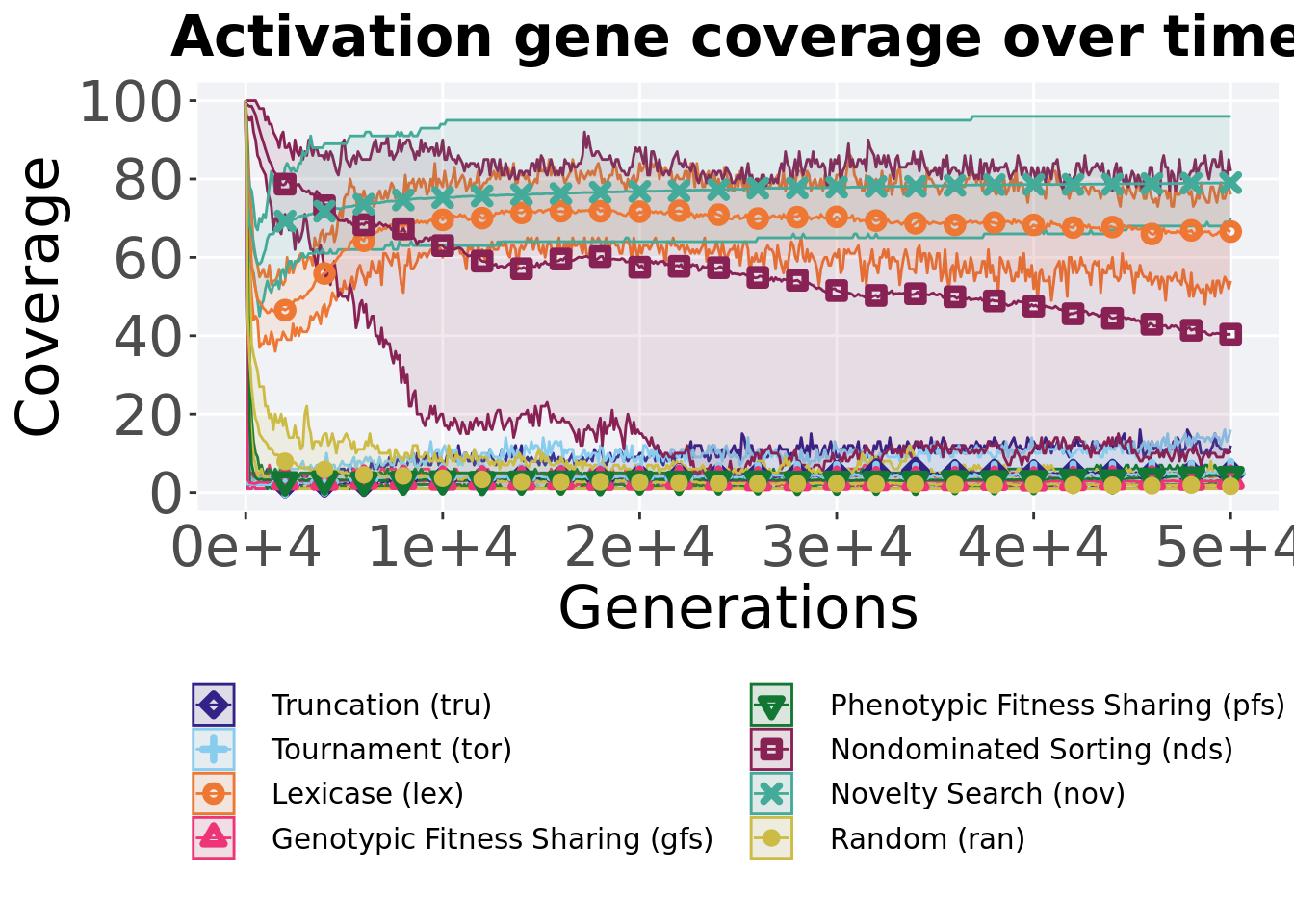
5.4.2.2 Coverage comparison
Best activation gene coverage in the population at 40,000 and 50,000 generations.
# 80% and final generation comparison
end = filter(cc_over_time_mvc, diagnostic == 'multipath_exploration' & gen == 50000 & acron != 'ran')
end$Generation <- factor(end$gen)
mid = filter(cc_over_time_mvc, diagnostic == 'multipath_exploration' & gen == 40000 & acron != 'ran')
mid$Generation <- factor(mid$gen)
mvc_p = ggplot(mid, aes(x = acron, y=uni_str_pos, group = acron, shape = Generation)) +
geom_point(col = mvc_col[1] , position = position_jitternudge(jitter.width = .03, nudge.x = -0.05), size = 2, alpha = 1.0) +
geom_boxplot(position = position_nudge(x = -.17, y = 0), lwd = 0.7, col = mvc_col[1], fill = mvc_col[1], width = .1, outlier.shape = NA, alpha = 0.0) +
geom_point(data = end, aes(x = acron, y=uni_str_pos), col = mvc_col[2], position = position_jitternudge(jitter.width = .03, nudge.x = 0.05), size = 2, alpha = 1.0) +
geom_boxplot(data = end, aes(x = acron, y=uni_str_pos), position = position_nudge(x = .17, y = 0), lwd = 0.7, col = mvc_col[2], fill = mvc_col[2], width = .1, outlier.shape = NA, alpha = 0.0) +
scale_y_continuous(
name="Coverage",
limits=c(0, 100),
breaks=seq(0,100, 20),
labels=c("0", "20", "40", "60", "80", "100")
) +
scale_x_discrete(
name="Scheme"
)+
scale_shape_manual(values=c(0,1))+
scale_colour_manual(values = c(mvc_col[1],mvc_col[2])) +
p_theme
plot_grid(
mvc_p +
ggtitle("Activation gene coverage comparisons") +
theme(legend.position="none"),
legend,
nrow=2,
rel_heights = c(1,.05),
label_size = TSIZE
)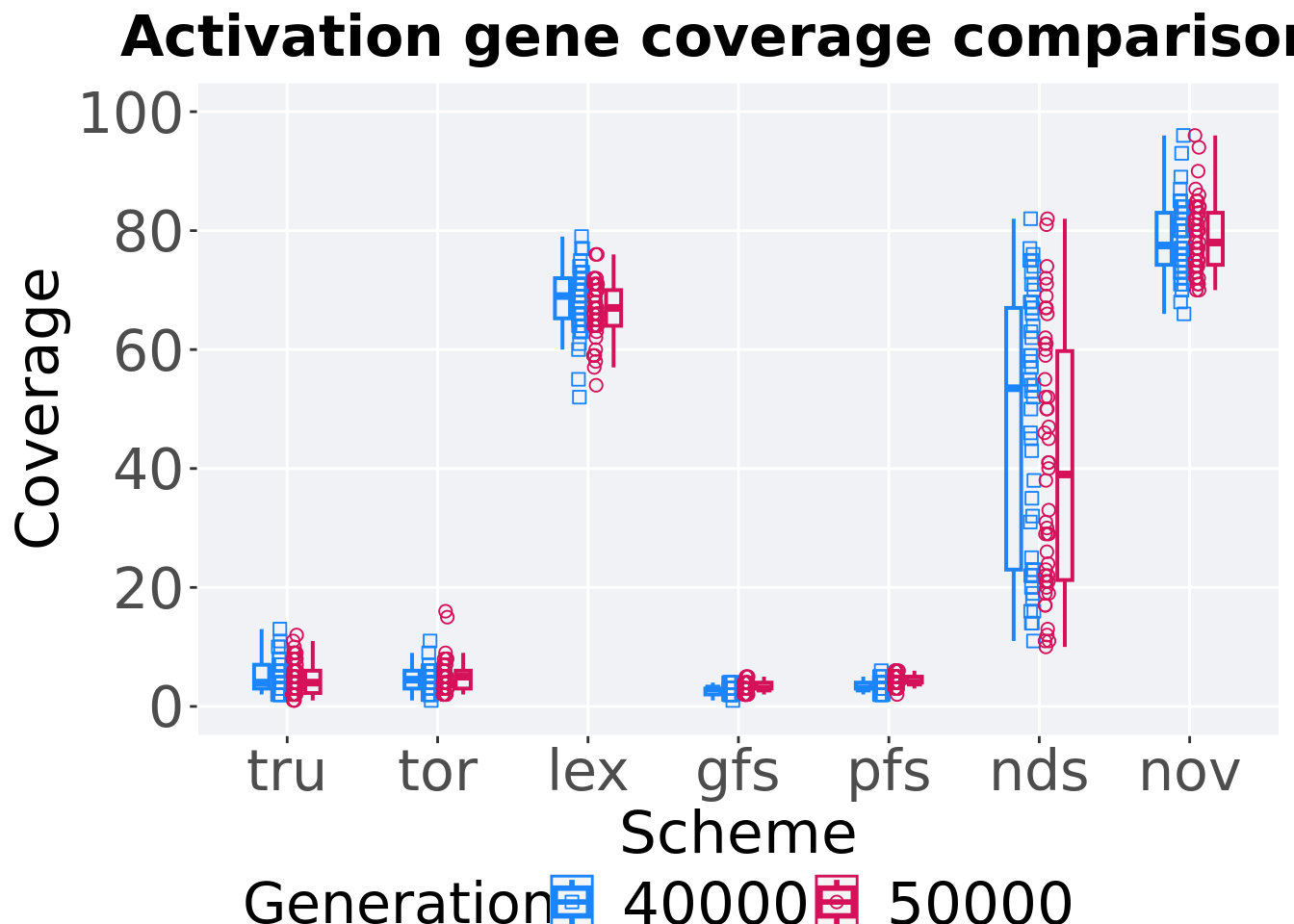
5.4.2.3 Stats
Summary statistics for the activation gene coverage at 40,000 and 50,000 generations.
slices = filter(cc_over_time_mvc, diagnostic == 'multipath_exploration' & (gen == 50000 | gen == 40000) & acron != 'ran')
slices$Generation <- factor(slices$gen, levels = c(50000,40000))
slices$acron = factor(slices$acron, levels = c('nov','lex', 'nds','tru','tor','gfs','pfs','ran'))
slices %>%
group_by(acron, Generation) %>%
dplyr::summarise(
count = n(),
na_cnt = sum(is.na(uni_str_pos)),
min = min(uni_str_pos, na.rm = TRUE),
median = median(uni_str_pos, na.rm = TRUE),
mean = mean(uni_str_pos, na.rm = TRUE),
max = max(uni_str_pos, na.rm = TRUE),
IQR = IQR(uni_str_pos, na.rm = TRUE)
)## `summarise()` has grouped output by 'acron'. You can override using the
## `.groups` argument.## # A tibble: 14 x 9
## # Groups: acron [7]
## acron Generation count na_cnt min median mean max IQR
## <fct> <fct> <int> <int> <int> <dbl> <dbl> <int> <dbl>
## 1 nov 50000 50 0 70 78 79.1 96 8.75
## 2 nov 40000 50 0 66 77.5 78.6 96 8.75
## 3 lex 50000 50 0 54 67 66.6 76 6
## 4 lex 40000 50 0 52 69 68.3 79 6.75
## 5 nds 50000 50 0 10 39 40.4 82 38.5
## 6 nds 40000 50 0 11 53.5 47.5 82 44
## 7 tru 50000 50 0 1 4 4.8 12 3.75
## 8 tru 40000 50 0 2 4 4.78 13 4
## 9 tor 50000 50 0 2 5 5.1 16 3
## 10 tor 40000 50 0 1 4.5 4.38 11 3
## 11 gfs 50000 50 0 2 3 3.14 5 1
## 12 gfs 40000 50 0 1 3 2.72 4 1
## 13 pfs 50000 50 0 2 4 4.34 6 1
## 14 pfs 40000 50 0 2 3 3.28 6 1Truncation selection comparisons.
wilcox.test(x = filter(slices, acron == 'tru' & Generation == 50000)$uni_str_pos,
y = filter(slices, acron == 'tru' & Generation == 40000)$uni_str_pos,
alternative = 't')##
## Wilcoxon rank sum test with continuity correction
##
## data: filter(slices, acron == "tru" & Generation == 50000)$uni_str_pos and filter(slices, acron == "tru" & Generation == 40000)$uni_str_pos
## W = 1254.5, p-value = 0.9778
## alternative hypothesis: true location shift is not equal to 0Tournament selection comparisons.
wilcox.test(x = filter(slices, acron == 'tor' & Generation == 50000)$uni_str_pos,
y = filter(slices, acron == 'tor' & Generation == 40000)$uni_str_pos,
alternative = 't')##
## Wilcoxon rank sum test with continuity correction
##
## data: filter(slices, acron == "tor" & Generation == 50000)$uni_str_pos and filter(slices, acron == "tor" & Generation == 40000)$uni_str_pos
## W = 1396, p-value = 0.3094
## alternative hypothesis: true location shift is not equal to 0Lexicase selection comparisons.
wilcox.test(x = filter(slices, acron == 'lex' & Generation == 50000)$uni_str_pos,
y = filter(slices, acron == 'lex' & Generation == 40000)$uni_str_pos,
alternative = 't')##
## Wilcoxon rank sum test with continuity correction
##
## data: filter(slices, acron == "lex" & Generation == 50000)$uni_str_pos and filter(slices, acron == "lex" & Generation == 40000)$uni_str_pos
## W = 992.5, p-value = 0.07568
## alternative hypothesis: true location shift is not equal to 0Genotypic fitness sharing comparisons.
wilcox.test(x = filter(slices, acron == 'gfs' & Generation == 50000)$uni_str_pos,
y = filter(slices, acron == 'gfs' & Generation == 40000)$uni_str_pos,
alternative = 't')##
## Wilcoxon rank sum test with continuity correction
##
## data: filter(slices, acron == "gfs" & Generation == 50000)$uni_str_pos and filter(slices, acron == "gfs" & Generation == 40000)$uni_str_pos
## W = 1573, p-value = 0.01769
## alternative hypothesis: true location shift is not equal to 0Phenotypic fitness sharing comparisons.
wilcox.test(x = filter(slices, acron == 'pfs' & Generation == 50000)$uni_str_pos,
y = filter(slices, acron == 'pfs' & Generation == 40000)$uni_str_pos,
alternative = 't')##
## Wilcoxon rank sum test with continuity correction
##
## data: filter(slices, acron == "pfs" & Generation == 50000)$uni_str_pos and filter(slices, acron == "pfs" & Generation == 40000)$uni_str_pos
## W = 1914.5, p-value = 2.023e-06
## alternative hypothesis: true location shift is not equal to 0Nondominated sorting comparisons.
wilcox.test(x = filter(slices, acron == 'nds' & Generation == 50000)$uni_str_pos,
y = filter(slices, acron == 'nds' & Generation == 40000)$uni_str_pos,
alternative = 't')##
## Wilcoxon rank sum test with continuity correction
##
## data: filter(slices, acron == "nds" & Generation == 50000)$uni_str_pos and filter(slices, acron == "nds" & Generation == 40000)$uni_str_pos
## W = 1008, p-value = 0.09584
## alternative hypothesis: true location shift is not equal to 0Novelty search comparisons.
wilcox.test(x = filter(slices, acron == 'nov' & Generation == 50000)$uni_str_pos,
y = filter(slices, acron == 'nov' & Generation == 40000)$uni_str_pos,
alternative = 't')##
## Wilcoxon rank sum test with continuity correction
##
## data: filter(slices, acron == "nov" & Generation == 50000)$uni_str_pos and filter(slices, acron == "nov" & Generation == 40000)$uni_str_pos
## W = 1295.5, p-value = 0.756
## alternative hypothesis: true location shift is not equal to 0